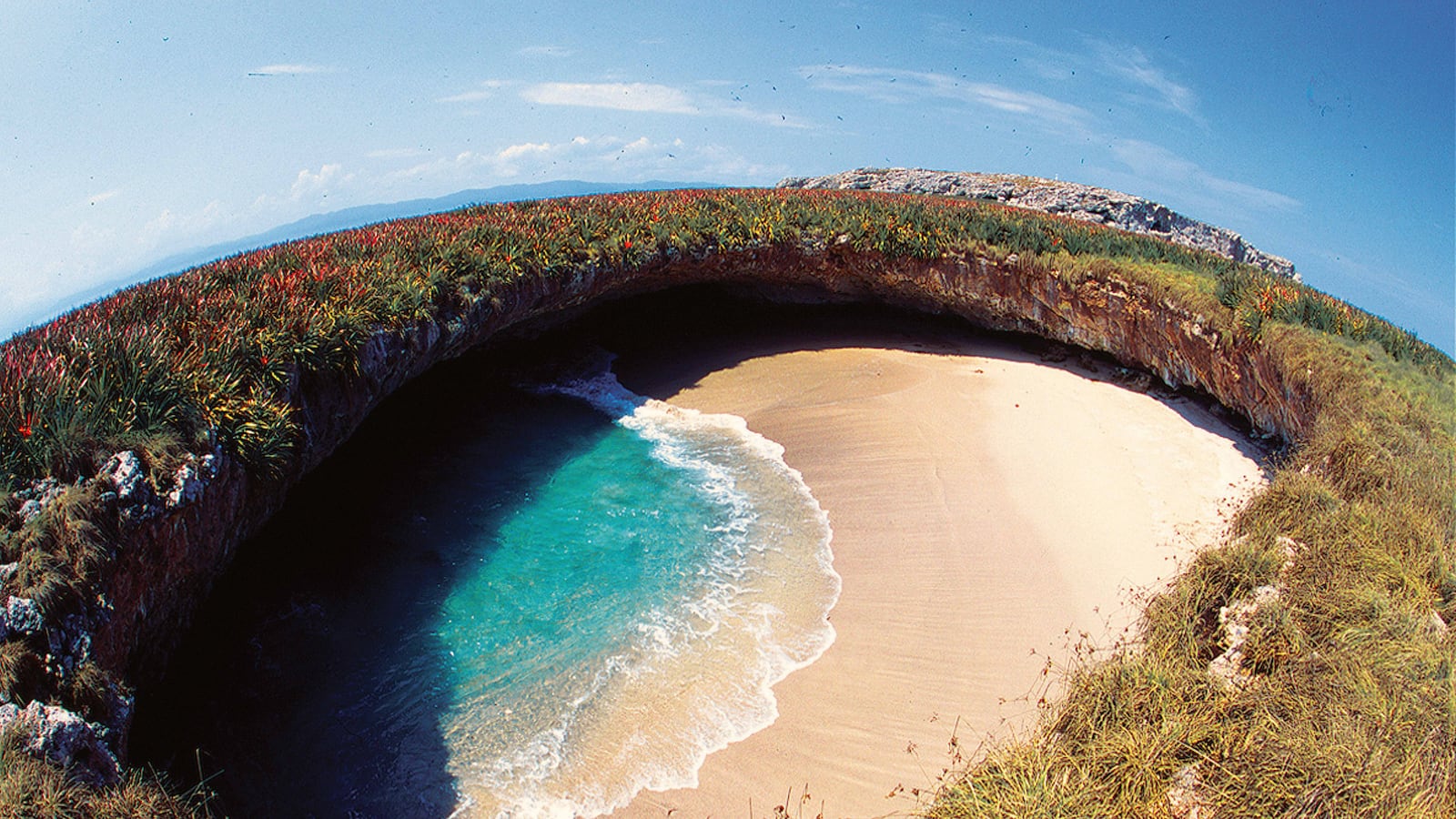It’s sunset in the pre-Columbian wilds of Nayarit. The jays silence their song as night falls. The jaguars lurk nearby. Smoke rises above the canopy as gentle chanting rumbles across the jungle floor. The Huichol—ancient dwellers of Mexico’s Pacific coast—burn flowers and seeds in honor of their gods. They sing songs and recite prayers in order to maintain the holy balance of nature between Father Sun and Mother Ocean.
“For thousands of years the Huichol have performed these sacred rituals,” explains Enrique Alejos, the cultural concierge at the Four Seasons Punta Mita. “The masculine deities of light and the female goddesses of the dark work in unison through dutiful tribute in order to protect the precarious lives of the indigenous people.” And the gods’ Olympus, if you will, is a small couplet of islands just beyond the luxury hotel, where the sun rejoins the sea after its daily journey across the clouds.
Uninhabited by humans since its explosive inception over five million years ago, the volcanic Marieta Islands symbolized the tangible union of sea and sky to the god-fearing Huichol. But when modern-day conservationists surveyed the offshore rocks they discovered something even more ethereal lurking within.
At the center of Isla Redonda was a quirk of nature seen only on the pages of a fantasy novel—a sandy beach carved into the rounded core of the island like the hole of donut. Although completely invisible from the shoreline, a bird's eye view reveals lapping crystal waters and an empty dune like dazzling colors at the end of kaleidoscope's funnel.
“You see a lot of bizarre geological formations from limestone, like in the Thailand, but with volcanic rocks it’s much more surprising to find a beach encased in stone like this,” posits Dr. Benjamin Black, a volcanologist and post-doctoral scholar at the University of California, Berkley. “Volcanic rocks tell a continuing story from the moment they form after an eruption. This tale of erosion—the slow grind of the sea against the rocks—is particularly unique.”
But there’s an added twist. Before the area fell under the jurisdiction of Mexico’s national park system, the lonely islands were used as a bombing test site by country’s military.
For years the government detonated explosives on the Marietas, far away from human contact, until a movement led by Jacques Cousteau encouraged the navy to cease their testing in order to protect the surrounding reefs and delicate breeding grounds of the migrating humpback whales.
“Tests measuring cosmogenic nuclides can determine exactly how the hidden beach was formed, but regardless of whether or not it began with erosion or a bomb, it’s nonetheless a perplexing geological oddity,” continues Black, who likens the rocky terrain to a cherry bon bon.
“Erosion always proceeds from the top down, so the interior of the island, before it was hollowed out, was likely made up of what we call ‘explosive’ rocks—fragments belched up by volcanic activity. These stones erode more quickly, while the island’s thick exterior shell is made of a substance that is less susceptible to decay.”
According to Black’s initial assessment, a few thousand years remain before erosion eats away at the delicate structure, turning the hidden beach into a crescent-moon cove.
“We are more concerned, however, of the impact that excessive visits might cause to the eco-system,” says Marc Murphy, the managing director of Riviera Nayarit’s convention and visitor’s bureau, who has witnessed a massive spike in tourism to the Marietas after a photo of the hidden Eden went viral approximately two years ago. “Excessive tourism could lead to a more rapid destruction of this sanctuary.”
Alejos and his colleagues at the Four Seasons count an average of 300 people a day who cross the shallow straight beyond the hotel to explore the now-famous ring of hidden peach sand.
Although tourists aren’t allowed to climb on the islands, according to the national park laws, they gain access to the secreted beach within through a submarine tunnel that is naturally chiseled into the island’s side. When the tides recede, the top of the long passageway emerges just above the waves allowing the right amount of space to swim through James Bond-style, sans scuba gear.
Once inside, there’s plenty of space to sunbathe or relax under the crown of arcing shrubs and rocks high above. From deep within, looking up at the tropical sky is like staring through the dome of some kind of earthen cathedral.
“The natural formation of an oculus in nature is extremely rare,” adds Black, who cites the prominence of rounded portals across many ancient cultures—“the Romans, for example, built oculi in their temples as a representation of their gods’ watchful eyes.”
“Here you have two mysterious openings, one from the sea and one to the sky,” Black continues, “no wonder the Huichol believed it was the holy place where Father Sun and Mother Ocean united.”






